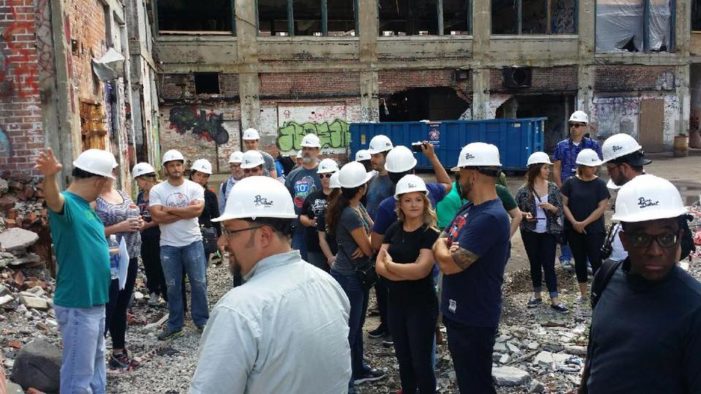If you thought the Packard Plant, a crumbling monstrosity on East Grand Boulevard and Mount Elliot Street would never amount to more than a tragic example of Detroit’s automotive manufacturing decline, you likely don’t didn’t know a retail company – Pure Detroit – and its 18-year mission to promote and uplift the city.
The Packard, a decaying factory that pumped out some of the world’s finest, most advanced luxury cars in the first half of the last century, is about to symbolize another step in Detroit’s ongoing comeback. In fact, so many people want to peek inside this hulk that Pure Detroit is offering two tours each on Saturday and Sunday throughout the fall.
Co-owner of Pure Detroit Kevin Borsay says his team guides patrons through portions of the 3.5-million-square-foot facility on weekends to sell-out crowds, each person paying $40. The rules are stringent. The site can only accommodate 30 people at a time and visitors must sign up online in advance.

Tours of the Packard fit the mission of Pure Detroit, which opened in 1998 in the lobby of the David Whitney building.
“Pure Detroit’s mission is multi-faceted,” Borsay says. “As urbanists, we strive to create vibrant, ground-level retail activity in downtown Detroit. As proprietors, we seek to provide a touching point for residents and visitors to the city for Detroit’s rich history and contemporary culture.
Pure Detroit has five shops selling t-shirts, vintage photographs and a variety of Detroit themed items. Shops are in the Fisher and Guardian Buildings, Renaissance Center, Belle Isle Aquarium and the Strathmore apartments. The company also offers free tours of the Fisher and Guardian buildings on Saturdays. As much as the Fisher and Guardians are glittering office palaces, the Packard is a place of possibilities.
“We’re actually going inside the belly of the beast. The Packard is without doubt the largest dormant building in Detroit.” -Kevin Borsay, Co-Owner, Pure Detroit
Borsay works closely with Fernando Palazuelo, owner of Arte Express Detroit. He is the Peruvian developer who bought the 111-year old Packard Plant in 2013 for $405,000 in a Wayne County tax auction. Borsay and Palazuelo share the dream of transforming it into a viable, mixed-use complex.

“This is refreshing to see how many people are interested in the Packard, they keep coming out and they learn a lot,” says Borsay of the 90-minute walking tour.
Only portions of the building are viable for tourists including its tower, which has a spectacular view of the city, Belle Isle, the bridge between two buildings, the headquarters and vast stretches outside.
Guests gather at a shipping container turned visitor station. They are advised to wear sturdy, closed toe shoes for serious walking and bring a flashlight to see into the decrepit concrete rooms. The tour leaders issue hard hats to everyone and follow a predefined path.
Participants learn the history of America’s foremost automobile, the trauma of a dormant plant and the vision for the building’s future.
Packard was an American luxury car marque founded in Warren, Ohio, in 1899 by brothers James Ward Packard and William Doud Packard, but Michigan-based investors prompted the move that led to the Packard Motor Car Company of Detroit. The firm started building cars that year and built the last pure Packard in 1956. Car manufacturing was interrupted during World War II when the plant was at the heart of the Arsenal of Democracy, building Rolls Royce engines for airplanes and ships.

The Detroit Packard plant designed by Albert Kahn Associates in 1903 had 5 million square feet of assembly space in nine separate buildings. It was reduced to 3.5 million square feet spread across 40 acres after the I-94 freeway opened.
Packard bought Studebaker in 1953 and formed Studebaker-Packard Corporation of South Bend, Indiana. Financial problems and the critical condition of that company forced it to consolidate all operations on August 15, 1956 at Studebaker’s South Bend facilities.
That same summer, Studebaker-Packard inked a deal with the Curtiss-Wright Corporation in a desperate and failed evade bankruptcy. After 1956 the manufacturing plant and the precedent-setting proving grounds in Shelby Township deteriorated.
The final Packards were actually badged as 1958 Studebakers.
Over the years a portion of the plant became a retail store, a paintball palace, a garage for storing classic cars and a haven for urban spelunkers, who took photographs and painted graffiti on all its walls.
Dominic Cristini owned the plant under the name BioResource for a dozen or so years and thwarted its demolition when then-mayor Dennis Archer sought to tear down the symbol of neglect. The building deteriorated even further until Palazuelo, an angel investor, turned up.
 Palazuelo is developing a comprehensive plan for restoring the building. Public relations counselor Colleen Robar has already reserved office space when it reopens and the Display Group opened its headquarters in a building next to the plant.
Palazuelo is developing a comprehensive plan for restoring the building. Public relations counselor Colleen Robar has already reserved office space when it reopens and the Display Group opened its headquarters in a building next to the plant.
During the tour visitors can hear more and some may get onboard with the restoration.
“We’re actually going inside the belly of the beast,” Borsay says. The Packard is without doubt the largest dormant building in Detroit.
“Our walking tours will offer a unique and enriching experience that contributes to the vitality of the city,” Borsay says.

For more information please visit the Packard Project’s website.
For tour information contact tours@puredetroit.com. Visitors must come with valid identification and must sign a waiver. No dogs are allowed on the tour.


